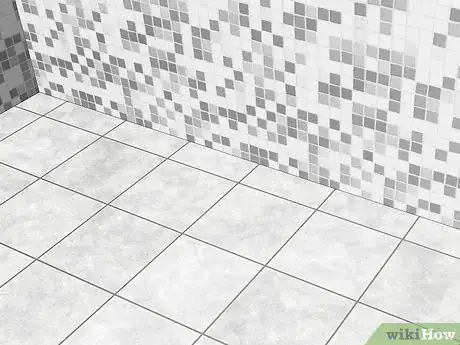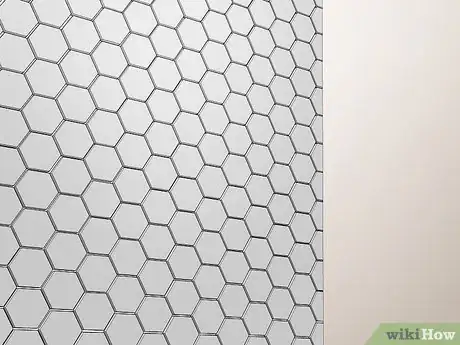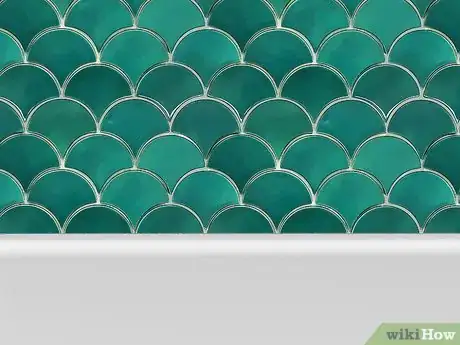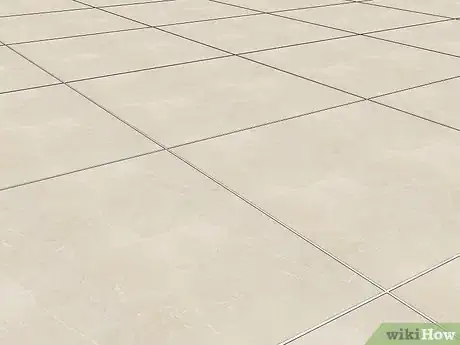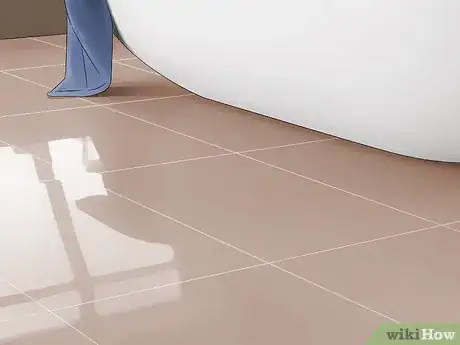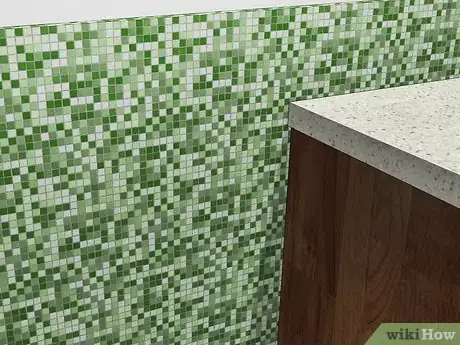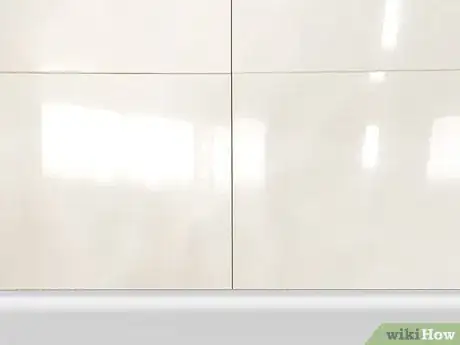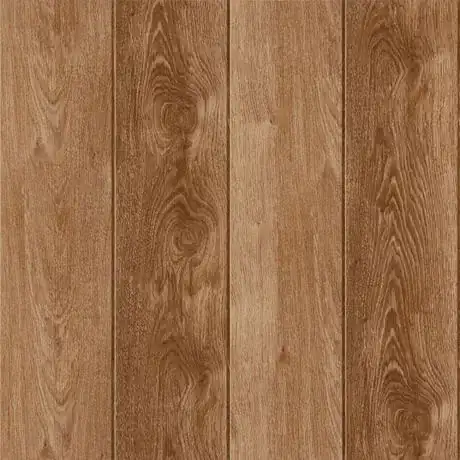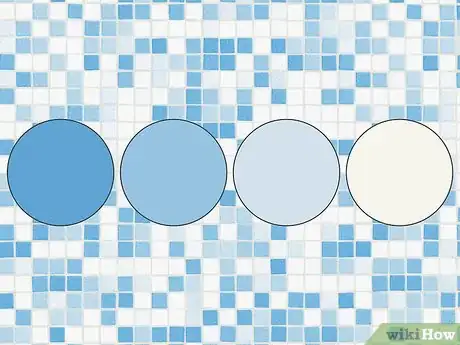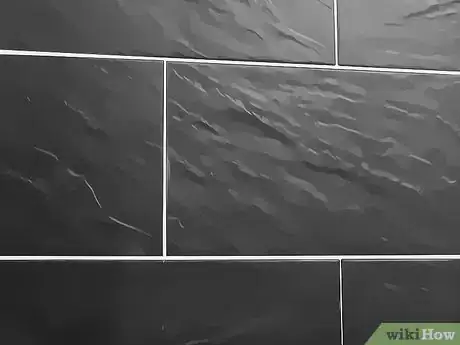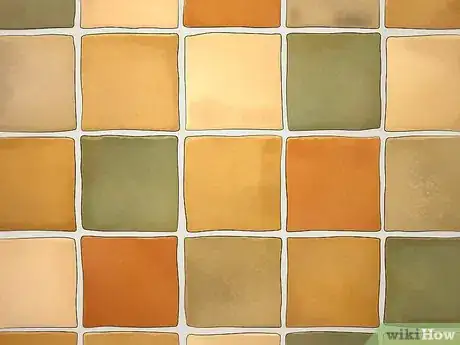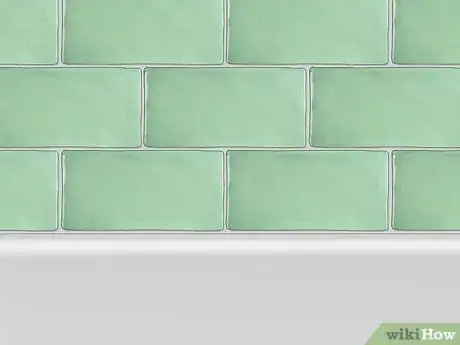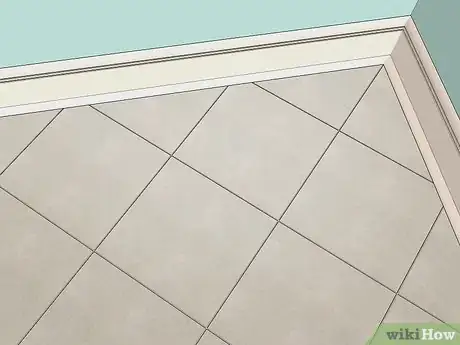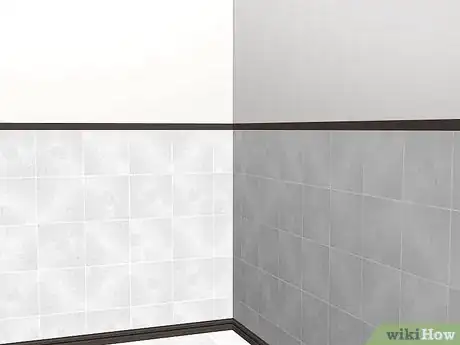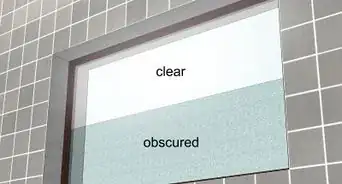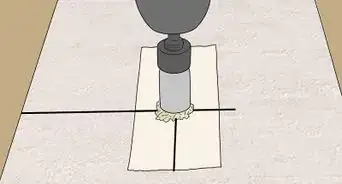This article was co-authored by Art Fricke. Art Fricke is a home renovation and repair specialist and the owner of Art Tile & Renovation based in Austin, Texas. With over 10 years of experience, he specializes in bathroom and kitchen renovations. Art focuses on a single contractor approach to customized renovation work, and performs projects such as installing custom tile showers, fixing tiled shower leaks, replacing cracked tiles, and installing floor and wall tile.
There are 13 references cited in this article, which can be found at the bottom of the page.
This article has been viewed 17,676 times.
Changing the look of your bathroom is exciting and refreshing! But picking the right tiles can be tricky, what with the vast array of shapes, colors, and patterns you can choose from. Refer to the size of the room, how much light it gets, and your desired design esthetic to help determine the best tiles for your space.
Steps
Choosing the Size and Shape
-
1Select larger tiles to make small bathrooms look larger. Lots of grout lines of smaller tiles can make small bathrooms look closed-in and cluttered. Larger tiles will have fewer grout lines that divide surface into boxes.[1]
- Grout lines are the mortar-like mixture that's put between tiles to make the surface resistant to water.
-
2Use different sized tiles in each part of the room to expand certain areas. If you have a small space, layer most of the bathroom in larger tiles (like the floor and walls) and use smaller tiles for the shower area and/or backsplash. Choose the same colored tiles with similar sheen and texture.[2]
- When it comes to size and textures for floors and backsplashes, smooth, large or medium-sized tiles are easier to wipe down.
Advertisement -
3Choose small tiles for slip-protection. Smaller tiles are ideal for surfaces that are inevitably going to get wet like showers (and areas just outside of showers). The grout lines provide traction under your feet as opposed to large marble or shiny tiles with no surface variation.[3]
- Large marble tiles provide the least traction and are best avoided in bathrooms that will be used by elderly persons.
-
4Blend odd geometric shapes together to add artistic flare. Combining a few different shapes together (like triangles, rhombuses, hexagons, octagons, and trapezoids) can look thoughtful and unique. Choose subtle hues or bold, contrasting colors to exacerbate the effect.[4]
- Select a grout color that isn't too subtle or too shocking to highlight the shapes in a graceful way.
- You may want to have a professional contractor lay the tiles for you, as tiles cut or painted for geometric patterns can be difficult to lay correctly.
-
5Add hexagonal tiles to an accent wall for an eye-catching look. Hexagonal tiles aren't very common, so putting them on a single accent wall will draw the eye to it. You can use all hexagonal tiles, but it won't have the same unique appeal as just using it on one wall.
- Choose a color and finish for the accent wall that are the same as the other tiles. For instance, if the floor and shower are lined in square, tan-colored granite, use the same color and type of granite for the hexagon-tiled area.
-
6Use peacock and other vintage shapes for a nostalgic look. Peacock shaped tiles are pointed at one end and curved at the other (like a peacock's plume). This shape looks great in alternating colors (like green or blue and black) or laid into a mosaic design.
- Place the peacock tiles inside of a simple border of square tiles to draw attention to the curved edges.
Selecting the Material and Finish
-
1Choose vinyl tiles for practicality and a low price. Vinyl is extremely durable and easy to install. It's also one of the most cost-effective tiles. It's comfortable to walk on and provides some traction against slipping.[5]
- You can cut vinyl into various shapes using a utility knife (and some cutting skills).
- If you want a stone look (without the hefty price), some manufacturers make stone-vinyl.
- You can also add a shiny and/or water-resistant finish to vinyl flooring.
-
2Select ceramic tiles for a low-cost option that's easy to install. Ceramic tiles are great if you're redoing a large area and don't want to spend a lot of money.[6] Ceramic tiles can be easily customized with different colors and designs using a variety of glazes. Plus, it's easy to keep clean![7]
- If you live in a cold climate, it will be chilly on your feet!
- Ceramic tiles don't stand up to moisture as well, so avoid putting them in showers and bathtubs.
- Glossy finishing will keep the ceramic looking shiny and new.
- Ceramic tiles are a great option for a DIY project as you can easily cut the tiles using a tile cutter.
-
3Use porcelain tiles for long-term durability. Porcelain is extremely hard and, if it chips, the color will stay the same (as opposed to ceramic tiles that are a different color under the surface). It can also stand up to areas of high-moisture like showers and bathtubs because it won't absorb water.[8]
- Durability comes at a price, as porcelain is more expensive than ceramic.
- Porcelain tiles are harder to cut and typically require professional installation.
-
4Choose natural stone tiles as an eco-friendly option. Natural stone tiles add warmth to the room and can match any decor. They're also more slip-friendly, making stone a great option for homes with children or elderly people. Natural stones include marble, slate, granite, limestone, sandstone, and travertine.[9]
- Stone tiles aren't as budget-friendly as other tile materials and can chip easily.
- Stone is naturally porous, so you'll have to regularly treat the tiles with a sealing agent to protect from stains or water damage.
-
5Opt for glass tiles for a relaxing, spa-like environment. Glass tiles look sleek and polished. Choose aquatic tones (light blues and greens) for a beachy feel and neutral hues for an elegant look. Glass is great for smaller bathrooms because it will help light bounce around the room.
- As a drawback, glass tiles show watermarks, streaks, smudges, and smears more than any other material. So be prepared to clean it often! Or, you can use smaller glass tiles to camouflage these minor imperfections.
- Glass tiles can be pricey—but if you still want to have some glass elements, use them for accent designs on the backsplash or shower wall.
-
6Cover the backsplash and floor in matte tiles for a sophisticated look. Matte and/or mossy colored tiles typically come in a single color with varying splotches of lighter and darker hues. Opt for a neutral color that goes well with the color of your cabinets and fixtures.
- For instance, a dark green mossy-matte backsplash pairs well with dark cherrywood cabinets, a black countertop, and a silver or gold faucet.[10]
- Matte finishes are easy to maintain and will disguise watermarks better than glossy tiles.
-
7Keep your tiles looking new and shiny with a glossy finish. Shiny tiles reflect light and can make your bathroom look larger (especially if there isn't a lot of natural light). A glossy finish is easy to wipe clean, but it will show water marks, footprints, soap smears, and dirt.
- A gloss finish provides little to no traction underfoot, so it can be a slip-hazard.
- Mimic the look of marble by adding a glossy finish to travertine stone.
-
8Go for a trendy and/or edgy look with metallic tiles. Metallic tiles will shine and reflect lots of light. Choose bright colors for a more playful look and darker hues for a romantic, bold esthetic. Smaller metallic tiles can add texture while medium-sized or larger tiles will exaggerate the reflective sheen.[11]
- Select metallic colors that complement the decor and non-metallic aspects of the room. For instance, if your cabinets are dark brown wood, choose a burgundy-brown metallic tile for a cohesive look. You can also select a wild, clashing color to add some spunk (like hot pink or electric blue).
-
9Choose Trendy Wood Look Tile Ideas for Bathrooms. Wood look tiles capture the beauty of wood and combine it with the durability of porcelain or ceramic tiles. They are an extremely popular choice for every area of the home, but now they are trending for bathroom decor. Whether your bathroom is small or large, wood look tiles can be a great choice to make your bathroom look rustic and sleek.
- This faux wood tile not only resembles the real wood but is also more durable and easier to maintain.
- Wood look tile is far less expensive than traditional hardwood flooring, making it a much more cost-effective option.
- Finding an exact match to wood look tiles for repairs can be difficult. So, make sure to store some extra tiles to use in case any repair is needed.
Picking the Color
-
1Use white or light pastel tiles to make a small bathroom look larger. Crisp white, ivory, eggshell, or off-white hues reflect light, making the space look larger than it is. If you're tiling parts of the walls as well, light colors will reflect light and widen the space.[12]
- Use bright white tiles for a contemporary look. In addition to making a space look larger, a bright, white bathroom looks refreshing and relaxing, especially with bathrooms that get lots of natural light.
- Complement the white color scheme with pops of neutral colors like blacks or grays. Add a few pops of blue, pink, red, green, or yellow for a little spunk.
- Add earth-toned accent tiles (like dandelion gold, burnt sienna, or sky blue) to mostly white bathrooms for a cottage-like feel.
-
2Choose small tiles in up to 4 similar colors to create an eye-catching mosaic. Working with smaller tiles allows you to play around with colors a little more. Select 1 to 4 shades of a single color to keep the eye moving and create a sense of depth.[13]
- If you like blue, try using royal blue as your main color and adding details of navy and light or medium blue.
- Use a mix of caramel, chocolate, and/or walnut brown tiles for a romantic, lush look. Add some baby blue or tan accents to lighten it up a bit.
- If you want to create a unique, ultra-modern look, choose 2 or 3 similar colors and 1 accent color to add a playful spark (e.g., use mostly a forest green, a little true green, and accent certain areas with a few pops of bright orange or lilac).
- Avoid overly busy designs, as these can look cluttered. Instead, focus on creating patterns of light and dark by fading the colors into one another (like an ombre effect).
-
3Choose tans and other neutrals that can adapt to multiple color schemes. If you like to redecorate a lot, choose neutral colors that will work well with various wall colors, fixtures, and decor. For instance, off-white or black tiles will fit into any new color scheme much better than teals, blues, or yellows.[14]
- Consider making a statement with white grout and black floors or vice-versa for a playful touch.
-
4Combine pastel blues and greens with crisp whites for a beachy retreat look. Aquatic colors (light ocean blues, sea-foam greens, and light sandy browns) are calming and will make you feel like you're right on the beach! These soft hues pair well with silver fixtures and light or dark wooden cabinets.
- Avoid adding too many pastels into the mix, as this can look kitschy. Keep it simple and focus on only 2 or 3 pastels.
- Increase the beach-appeal by combining pastel tiles with a tan colored stone (like marble, granite, or travertine).
-
5Blend earth-toned browns, greens, reds, and yellows for a natural look. Earthy tones look great with natural stone tiles and will make your bathroom feel like a cozy haven. Some other earthy tones include raw sienna, burnt umber, dandelion gold, mossy green and ochre rocky gray, and olive green.
- A combination of raw sienna, burnt umber, and mossy green will give off a nature lodge vibe.
- Earthy gold, olive green, and rocky gray mixed together will look like a mountain hideaway.
- Opt for matte finish with earth tones to keep the natural appeal.
-
6Feel refreshed by using bright greens and whites. Fresh, minty greens pair well with shades of white and will make your bathroom feel like a place for re-energizing yourself. Choose an electric lime green for a more playful, modern approach or a soft, natural mint for an understated (yet zesty) feel.
- For a zen-like atmosphere, opt for soft whites with jade green, adding wooden or gray-stone accents.
Creating Patterns with Tiles
-
1Lay square tiles diagonally for a clean, classic look. Diagonal squares make the room look ordered and clean. Choose the exact opposite color for the grout lines to enhance the geometric look or select grout lines in a similar or neutral color for a more subtle esthetic.[15]
- Keep grout lines clean by using a toothbrush to scrub away any dirt or residue.
-
2Make chevron patterns to elongate a room. Chevron tiles can be rectangles, rhombuses, or small stripes that form a zig-zag pattern when layered all together. This pattern is great for small bathrooms because the arrowhead design (formed by the conjoining shapes and lines) will trick the eye into thinking the space is larger than it is.[16]
- Use black and white tiles for a clean, classic look or pair white with any color of your choice—ideally one that complements the wall color, cabinets, and decor.
-
3Add a stripe of color at eye-level for an understated, modern touch. When working with single-colored tiles, adding a stripe of color right at eye-level (or a little above) can create height to the room. If you're using white tiles, try a stripe of gray. If you're using colored tiles for most or all of the bathroom, choose a similar or complementary color (like a lighter or darker hue of that same color).
- Make your stripe color the same as any accent colors you have around the room as decor (e.g., if you have a bright orange shelf, make the stripe match that same orange).
-
4Go for luxury with graphic marble tiles. Graphic marble tiles can feature geometric shapes or jagged, swirling, watercolor-like patterns that will take any bathroom to the next level of luxury. Choose black and white patterns for an elegant look or colored marbles (greens, maroons, blues) for a more playful, extravagant vibe. If genuine marble is too pricey, opt for synthetic marble.[17]
- Marble tiles contain natural minerals that can turn rust-colored from exposure to heat and moisture. Before installation, do a quick test by placing one of the tiles in a bucket of water for 2 days, taking it out, and letting it sit for 2 more days. Take pictures before and after to help you spot any changes.[18]
- You'll probably need to hire a contractor to come in and lay the tiles for you, as marble is extremely heavy and requires more care during installation.
-
5Avoid small checkerboard tiles in small bathrooms. The checked pattern can feel constrictive and too busy. However, if you'd rather use small tiles, stick with light colors and use mirrors to reflect light and create the illusion of space.[19]
- Place mirrors on different walls of the bathroom to bounce light around and make the space look larger.
- Replace yellow bulbs with white LED lights to add natural-looking light to windowless bathrooms.
Expert Q&A
-
QuestionWhat should I consider while tiling my bathroom?
 Art FrickeArt Fricke is a home renovation and repair specialist and the owner of Art Tile & Renovation based in Austin, Texas. With over 10 years of experience, he specializes in bathroom and kitchen renovations. Art focuses on a single contractor approach to customized renovation work, and performs projects such as installing custom tile showers, fixing tiled shower leaks, replacing cracked tiles, and installing floor and wall tile.
Art FrickeArt Fricke is a home renovation and repair specialist and the owner of Art Tile & Renovation based in Austin, Texas. With over 10 years of experience, he specializes in bathroom and kitchen renovations. Art focuses on a single contractor approach to customized renovation work, and performs projects such as installing custom tile showers, fixing tiled shower leaks, replacing cracked tiles, and installing floor and wall tile.
Home Renovation & Repair Specialist When tiling walls, you might discover some drywall that needs repairing. Be sure to address that issue before laying the tiles to avoid water damage or other issues down the line.
When tiling walls, you might discover some drywall that needs repairing. Be sure to address that issue before laying the tiles to avoid water damage or other issues down the line. -
QuestionWhat tile material should I use for my bathroom?
 Art FrickeArt Fricke is a home renovation and repair specialist and the owner of Art Tile & Renovation based in Austin, Texas. With over 10 years of experience, he specializes in bathroom and kitchen renovations. Art focuses on a single contractor approach to customized renovation work, and performs projects such as installing custom tile showers, fixing tiled shower leaks, replacing cracked tiles, and installing floor and wall tile.
Art FrickeArt Fricke is a home renovation and repair specialist and the owner of Art Tile & Renovation based in Austin, Texas. With over 10 years of experience, he specializes in bathroom and kitchen renovations. Art focuses on a single contractor approach to customized renovation work, and performs projects such as installing custom tile showers, fixing tiled shower leaks, replacing cracked tiles, and installing floor and wall tile.
Home Renovation & Repair Specialist Ceramic tile is a great choice that's cost-effective and looks beautiful in a bathroom.
Ceramic tile is a great choice that's cost-effective and looks beautiful in a bathroom.
Warnings
- If your bathroom has floor drains, make sure to lay the tiles at a slope to avoid any puddles or lingering moisture.⧼thumbs_response⧽
- Use a professional contractor when working with large, heavy, and/or expensive tiles—especially if you've never installed tile before!⧼thumbs_response⧽
References
- ↑ https://www.realhomes.com/design/choosing-the-right-size-tiles-for-a-small-bathroom
- ↑ https://www.realhomes.com/design/choosing-the-right-size-tiles-for-a-small-bathroom
- ↑ https://www.marazziusa.com/factors
- ↑ https://www.interiordesign.net/projects/13941-7-tile-and-laminate-standouts/
- ↑ https://www.bobvila.com/articles/7725-bathroom-floor-tile-which-is-best-for-your-bath/
- ↑ Art Fricke. Home Renovation & Repair Specialist. Expert Interview. 1 July 2020.
- ↑ https://www.bobvila.com/articles/porcelain-vs-ceramic-tile/
- ↑ https://www.bobvila.com/articles/porcelain-vs-ceramic-tile/
- ↑ https://bozeman.floorcoveringsinternational.com/blog/pros-and-cons-of-natural-stone-tile-flooring/
- ↑ https://sebringdesignbuild.com/top-trends-in-bathroom-tile-design/
- ↑ https://www.lushome.com/metal-tiles-modern-curve/1798
- ↑ https://www.bathstore.com/bathroom-ideas/blog/the-experts-blog/how-to-make-a-small-bathroom-look-bigger
- ↑ https://www.realhomes.com/design/choosing-the-right-size-tiles-for-a-small-bathroom
- ↑ https://www.dwell.com/article/7-essential-tips-for-choosing-the-perfect-bathroom-tile-04612a32
- ↑ https://www.interiordesign.net/projects/13941-7-tile-and-laminate-standouts/
- ↑ https://www.interiordesign.net/projects/13941-7-tile-and-laminate-standouts/
- ↑ https://sebringdesignbuild.com/top-trends-in-bathroom-tile-design/
- ↑ https://www.houzz.com/magazine/why-marble-might-be-wrong-for-your-bathroom-stsetivw-vs~12133357
- ↑ https://www.moen.com/inspiration/bathroom/make-small-bathroom-bigger-high-end-look

